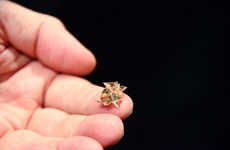
This European Space Agency Rover Will Be Controlled From Earth Orbit
Rahul Kalvapalle — August 31, 2015 — Tech
The Interact Centaur is a new earthbound rover, developed by the European Space Agency, that will be remotely controlled by Danish astronaut Andreas Mogensen as he floats around in orbit aboard the International Space Station.
The rover consists of a mobile platform with an articulated camera beam, various sensors and a pair of arms designed to be able to carry out highly precise operations. The robot's haptic controls provide force feedback, allowing Mogensen to literally feel as if he's working through the robot's arms while carrying out a task.
Given that earthlings have ambitious plans to have a presence on the moon, Mars and perhaps even beyond, it will be important to figure out how to control robotic rovers from orbit, which is why this European Space Agency project is so important.
The rover consists of a mobile platform with an articulated camera beam, various sensors and a pair of arms designed to be able to carry out highly precise operations. The robot's haptic controls provide force feedback, allowing Mogensen to literally feel as if he's working through the robot's arms while carrying out a task.
Given that earthlings have ambitious plans to have a presence on the moon, Mars and perhaps even beyond, it will be important to figure out how to control robotic rovers from orbit, which is why this European Space Agency project is so important.
Trend Themes
1. Remote-controlled Rovers - The development of remotely controlled rovers allows for precise operations in space exploration.
2. Haptic Feedback Technology - The use of haptic controls and force feedback enables astronauts to physically interact with robots in space.
3. Space Exploration Robotics - Robotic rovers controlled from orbit are paving the way for future missions to the moon, Mars, and beyond.
Industry Implications
1. Space Exploration - The space exploration industry can leverage remote-controlled rovers to advance research and missions in space.
2. Robotics and Automation - The robotics industry can explore haptic feedback technology to enhance human-robot interactions in various applications.
3. Aerospace Engineering - Aerospace engineers can contribute to the development of space exploration robotics and remote control systems for rovers.
1.4
Score
Popularity
Activity
Freshness























